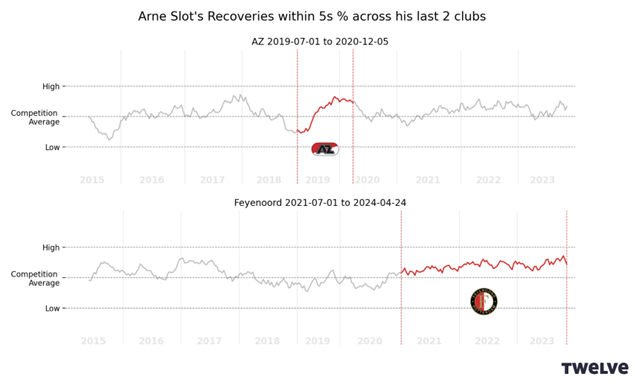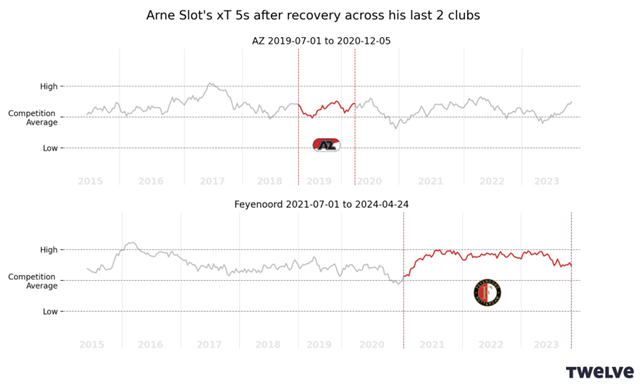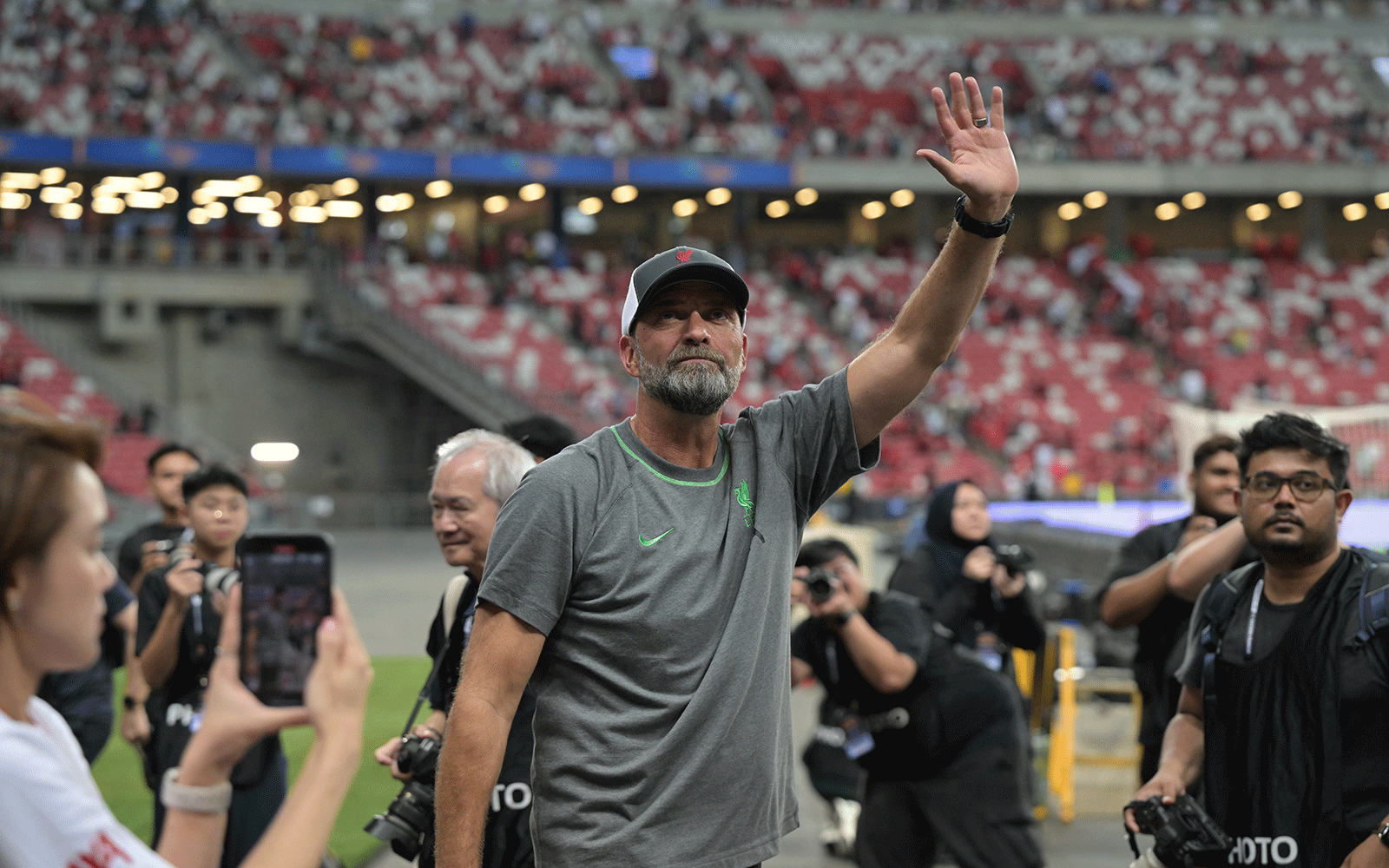Liverpool’s talismanic manager Jurgen Klopp is leaving the football club at the end of the 2023/24 season to be replaced by Arne Slot. It was reported that data analytics would play a key role in recruiting his successor. But how might that have worked?
The first meeting, in November 2015, between Jurgen Klopp and Ian Graham, Liverpool’s then data scientist, was a key moment for football analytics.
Their discussion focussed on a game that took place a year earlier between Borussia Dortmund, the team Klopp coached before moving to Liverpool, and Mainz. Graham showed Klopp that, although Dortmund had lost 2-0, they had twice as many expected goals in the match. Expected goals are an estimate of the probability that a shot taken from a particular position on the pitch will result in a goal, so Dortmund had been very unlucky to concede two and not to score themselves. And that particular game was one of the unluckiest results of a very unlucky run for Klopp, which had seen his team sink to 7th in the Bundesliga in his final season as manager.
When Liverpool had been assessing potential managers, Graham had, using the expected goals model, allayed any remaining concerns within the club that Klopp wasn’t up to the task. Klopp is later quoted, by New York Times journalist Bruce Schoenfeld, as saying of Graham and his staff, that “they’re the reason I’m here.”
Klopp was signed and the rest is history. And now he’s leaving.
The use of mathematical modelling in football has increased rapidly since 2015. The expected goals used by Graham are just a small part of a wide array of tools now used by clubs to measure everything from how players run to create space to the networks of passes made within teams. At that time, Liverpool’s faith in numbers was something of an exception. Now it is the rule.
One of the big recent advances in football analytics, as more data has become available, is an increased focus on style-of-play: checking that managers fit the culture of the team they will manage and that the players will fit into the team. We decided to use this approach to look at Liverpool and identify potential replacements for Klopp.

Liverpool’s very distinctive style of play is captured in the distribution plot above. Six different metrics are shown: defensive intensity, defensive line height, time to defensive action, recoveries within 5 seconds, expected threat (“xT”) 5 seconds after recovery and non-penalty expected goals. The white circle is Liverpool, the pink circles are other Premier League teams. All the statistics are standardised by taking away the mean and dividing by the standard deviation to give z-scores. This standardisation of metrics allows us to summarise teams in a single picture.
For Liverpool, the distribution plot reveals they are Premier League outliers in both defensive intensity and counterattacking. They make more defensive actions than any other team when they don’t have the ball; they are quick to react when they lose the ball and often win it back; and they go on to create danger (measured by xT, expected threat) once they make those recoveries. This intensity leads to a lot of dangerous chances (measured by non-penalty expected goals, or “np xG”). This is the Liverpool way: fast and furious in both defence and attack.
Now to the big question, with Klopp leaving, which other potential managers can coach this style effectively?
Let’s start with the one who got away: Xabi Alonso, a previous favourite with the bookmakers, declared he would stay at Bayer Leverkusen. Unfortunately for Liverpool, we can see from the plot below why he would have been a good choice for the team he won the Champions League with in 2005 with as a player. When he took over as manager of Leverkusen, the team’s ability to create danger, through passes and carries which increase the team’s chance of scoring five seconds after recovering the ball (xT 5s after recovery) shot upwards. Similar dramatic changes can also be seen if we plot time series of ‘time to defensive action’ and the other ‘fast and furious’ metrics (see this link for a more detailed analysis of these). Although Alonso does not have a lot of managerial experience, and it could be argued that Leverkusen were performing unusually poorly when he took over, there is no doubt that he can get a team to play the Liverpool way.

The bookmakers’ favourites after Alonso declined were Roberto De Zerbi (the Brighton Hove Albion manager) and Ruben Amorim (who currently manages Sporting in Portugal). We look below at both of their records in terms of how their teams generate threat after a recovery.


Attacking after winning back the ball is not an area De Zerbi specialises in. The Brighton coach has developed a more careful approach, based on build-up in his team’s own half. This makes him more of a natural choice for Barcelona (when they do need a replacement), than for Liverpool. On the other hand, Amorim has steadily improved Sporting’s ability to create after recovering the ball. This is a large part of Sporting CP’s rise to their current first place in Primeira Liga. There are also ways in which the Portuguese manager differs from Klopp: although starting their defence high up the pitch, Sporting don’t gegenpress (press as soon as they lose the ball) to the same degree as Liverpool do. His teams are fast, but maybe not quite as furious. A very good choice for Real Madrid, for example.
In a more detailed analysis we have looked further at Julian Nagelsmann, Thomas Tuchel and Unai Emery.
In the last few weeks, another name has emerged who looks poised to take over at Anfield: Arne Slot. Even before Klopp announced that he is leaving, Ian Graham’s successor William Spearman and his team will have been crunching the numbers. And it looks like they have been doing their job well. The first plot below shows how Slot rapidly increased AZ Alkamar’s recoveries within five seconds and has more steadily done the same thing at Feyenoord.

Then, the second plot shows just how much Feyenoord’s ability to create danger 5 seconds after they have won the ball back has become a steady feature of their game the last few seasons.

It looks very much as if Liverpool will have a new fast and furious manager next season and the Dutchman will Slot right into their style of play.
David Sumpter is professor of applied mathematics at the University of Uppsala, Sweden and a renowned global expert in AI for football analytics, advising top clubs and associations worldwide. He is also the best-selling author of the book Soccermatics and co-founder of the football data tool Twelve Football.
Ágúst Pálmason Morthens is a data scientist at Twelve Football and has a master’s degree in sports technology.
You might also like: Are professors and football stars just lucky?




